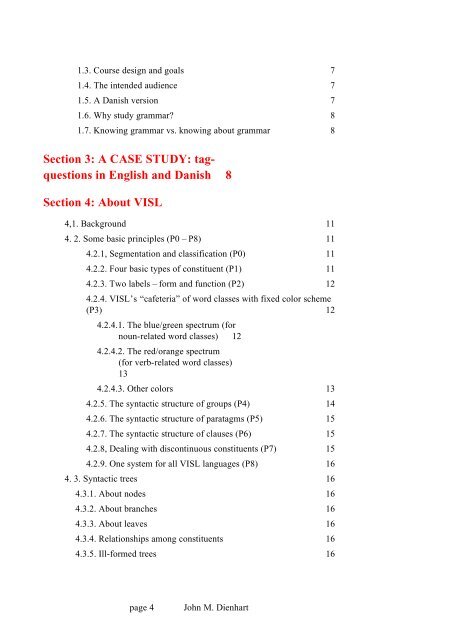Download - VISL
Download - VISL
Download - VISL
Create successful ePaper yourself
Turn your PDF publications into a flip-book with our unique Google optimized e-Paper software.
1.3. Course design and goals 7<br />
1.4. The intended audience 7<br />
1.5. A Danish version 7<br />
1.6. Why study grammar? 8<br />
1.7. Knowing grammar vs. knowing about grammar 8<br />
Section 3: A CASE STUDY: tagquestions<br />
in English and Danish 8<br />
Section 4: About <strong>VISL</strong><br />
4,1. Background 11<br />
4. 2. Some basic principles (P0 – P8) 11<br />
4.2.1, Segmentation and classification (P0) 11<br />
4.2.2. Four basic types of constituent (P1) 11<br />
4.2.3. Two labels – form and function (P2) 12<br />
4.2.4. <strong>VISL</strong>’s “cafeteria” of word classes with fixed color scheme<br />
(P3) 12<br />
4.2.4.1. The blue/green spectrum (for<br />
noun-related word classes) 12<br />
4.2.4.2. The red/orange spectrum<br />
(for verb-related word classes)<br />
13<br />
4.2.4.3. Other colors 13<br />
4.2.5. The syntactic structure of groups (P4) 14<br />
4.2.6. The syntactic structure of paratagms (P5) 15<br />
4.2.7. The syntactic structure of clauses (P6) 15<br />
4.2.8, Dealing with discontinuous constituents (P7) 15<br />
4.2.9. One system for all <strong>VISL</strong> languages (P8) 16<br />
4. 3. Syntactic trees 16<br />
4.3.1. About nodes 16<br />
4.3.2. About branches 16<br />
4.3.3. About leaves 16<br />
4.3.4. Relationships among constituents 16<br />
4.3.5. Ill-formed trees 16<br />
page 4<br />
John M. Dienhart
















